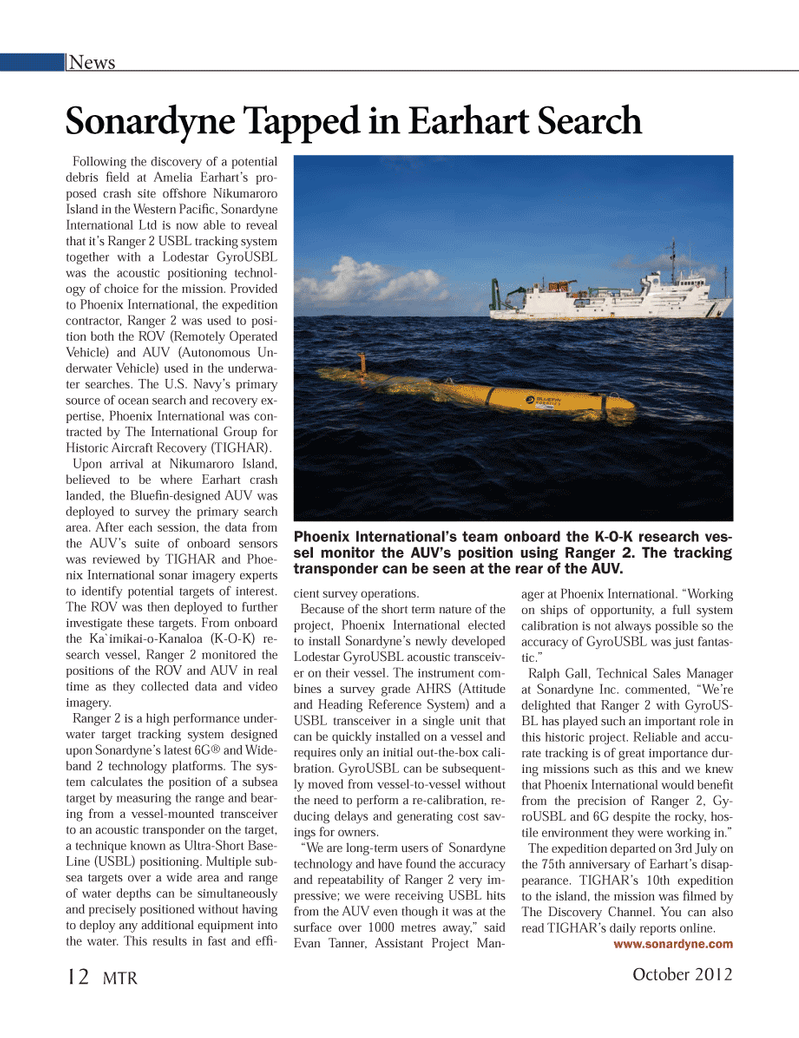
Page 12: of Marine Technology Magazine (October 2012)
Ocean Observation: Gliders, buoys & sub surface monitoring networks
Read this page in Pdf, Flash or Html5 edition of October 2012 Marine Technology Magazine
News Following the discovery of a potential debris Þ eld at Amelia EarhartÕs pro- posed crash site offshore Nikumaroro Island in the Western PaciÞ c, Sonardyne International Ltd is now able to reveal that itÕs Ranger 2 USBL tracking system together with a Lodestar GyroUSBL was the acoustic positioning technol- ogy of choice for the mission. Provided to Phoenix International, the expedition contractor, Ranger 2 was used to posi- tion both the ROV (Remotely Operated Vehicle) and AUV (Autonomous Un- derwater Vehicle) used in the underwa- ter searches. The U.S. NavyÕs primary source of ocean search and recovery ex- pertise, Phoenix International was con- tracted by The International Group for Historic Aircraft Recovery (TIGHAR). Upon arrival at Nikumaroro Island, believed to be where Earhart crash landed, the BlueÞ n-designed AUV was deployed to survey the primary search area. After each session, the data from the AUVÕs suite of onboard sensors was reviewed by TIGHAR and Phoe- nix International sonar imagery experts to identify potential targets of interest. The ROV was then deployed to further investigate these targets. From onboard the Ka`imikai-o-Kanaloa (K-O-K) re-search vessel, Ranger 2 monitored the positions of the ROV and AUV in real time as they collected data and video imagery. Ranger 2 is a high performance under- water target tracking system designed upon SonardyneÕs latest 6G¨ and Wide- band 2 technology platforms. The sys- tem calculates the position of a subsea target by measuring the range and bear- ing from a vessel-mounted transceiver to an acoustic transponder on the target, a technique known as Ultra-Short Base- Line (USBL) positioning. Multiple sub-sea targets over a wide area and range of water depths can be simultaneously and precisely positioned without having to deploy any additional equipment into the water. This results in fast and efÞ -cient survey operations. Because of the short term nature of the project, Phoenix International elected to install SonardyneÕs newly developed Lodestar GyroUSBL acoustic transceiv- er on their vessel. The instrument com- bines a survey grade AHRS (Attitude and Heading Reference System) and a USBL transceiver in a single unit that can be quickly installed on a vessel and requires only an initial out-the-box cali-bration. GyroUSBL can be subsequent-ly moved from vessel-to-vessel without the need to perform a re-calibration, re-ducing delays and generating cost sav- ings for owners. ÒWe are long-term users of Sonardyne technology and have found the accuracy and repeatability of Ranger 2 very im- pressive; we were receiving USBL hits from the AUV even though it was at the surface over 1000 metres away,Ó said Evan Tanner, Assistant Project Man- ager at Phoenix International. ÒWorking on ships of opportunity, a full system calibration is not always possible so the accuracy of GyroUSBL was just fantas- tic.Ó Ralph Gall, Technical Sales Manager at Sonardyne Inc. commented, ÒWeÕre delighted that Ranger 2 with GyroUS-BL has played such an important role in this historic project. Reliable and accu-rate tracking is of great importance dur- ing missions such as this and we knew that Phoenix International would beneÞ t from the precision of Ranger 2, Gy-roUSBL and 6G despite the rocky, hos- tile environment they were working in.Ó The expedition departed on 3rd July on the 75th anniversary of EarhartÕs disap- pearance. TIGHARÕs 10th expedition to the island, the mission was Þ lmed by The Discovery Channel. You can also read TIGHARÕs daily reports online. www.sonardyne.com Sonardyne Tapped in Earhart Search Phoenix International?s team onboard the K-O-K research ves- sel monitor the AUV?s position using Ranger 2. The tracking transponder can be seen at the rear of the AUV. October 201212 MTRMTR #8 (1-17).indd 12MTR #8 (1-17).indd 1210/3/2012 4:14:49 PM10/3/2012 4:14:49 PM

 11
11

 13
13
